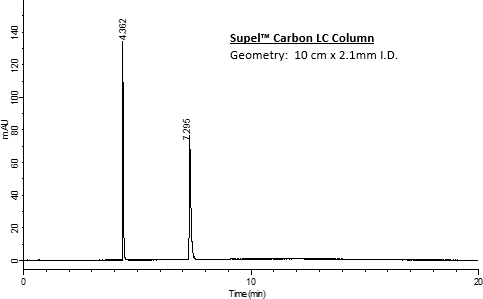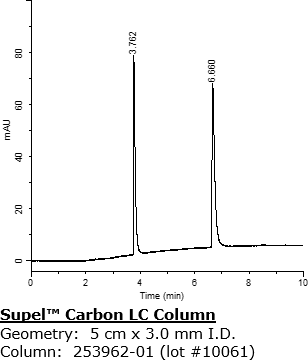UHPLC Analysis of Paraquat and Diquat on Supel™ Carbon LC
William L. Maule III, Clint Corman, Michael Ye, Cory Muraco, Curtis Frantz
MilliporeSigma, Bellefonte, PA
Paraquat and diquat are two toxic herbicides used to prevent the growth of invasive plant species. As both species are polar in nature, they can be difficult to resolve using conventional reversed phase chromatography. This application demonstrates the use of a Supel™ Carbon LC UHPLC column for retaining and resolving these two compounds. In addition, lot-to-lot reproducibility was investigated with two columns packed from different batches of the stationary phase.

Figure 1.Chemical Structures of Paraquat and Diquat.
Experimental Conditions for Diquat/Paraquat analysis |
|---|
Performance results and comparison

Figure 2.Analysis of Paraquat and Diquat on Supel™ Carbon LC.

Figure 3.Analysis of Paraquat and Diquat on Competitor Column.
Additional performance demonstrating lot-to-lot reproducibility with Supel™ Carbon LC columns
Experimental Conditions



Figure 4. Analysis of paraquat and diquat on two Supel™ Carbon LC columns and a Competitor Carbon Column. Note high degree of reproducibility between the two Supel™ Carbon LC columns. Tables below each image correspond to retention parameters of the compounds.
Conclusion
This application demonstrates the use of Supel™ Carbon LC column to give baseline resolution and excellent peak shape for the separation of the polar herbicides― diquat and paraquat. A unique and proprietary synthetic procedure, narrower particle size distribution, and less active surface results in more efficient and reproducible chromatographic separation compared to a different carbon column from another vendor. The Supel™ Carbon LC column is an ideal choice for polar compounds that are difficult to retain using typical RP columns.
To continue reading please sign in or create an account.
Don't Have An Account?